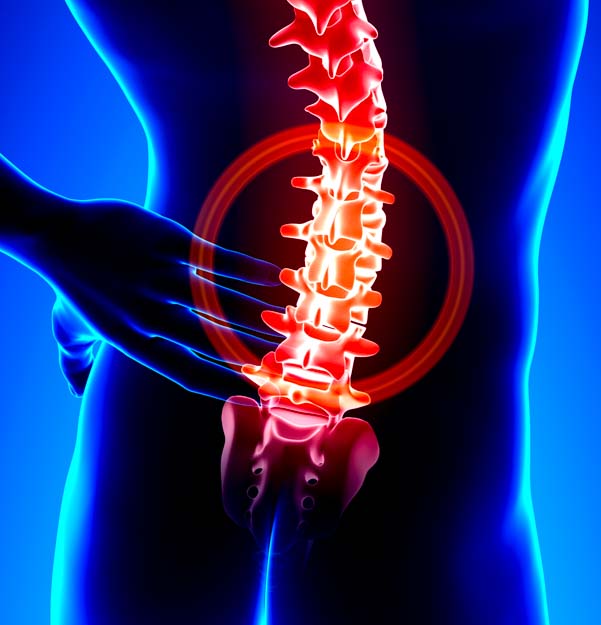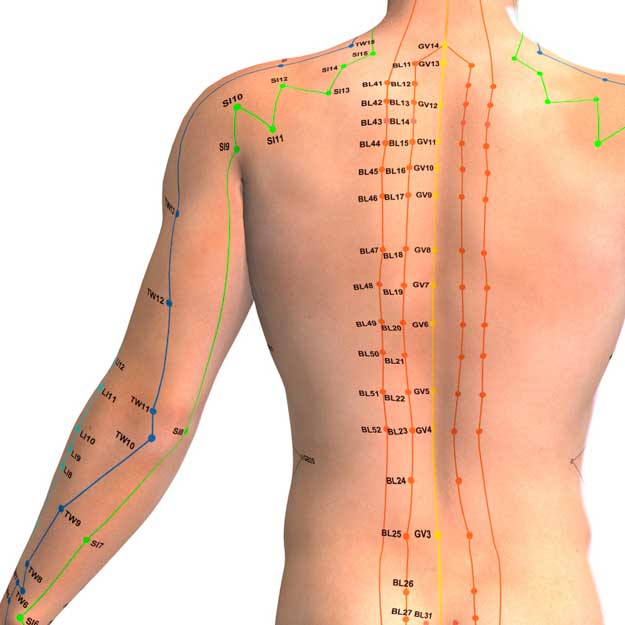Acupuncture relieves lower back pain and restores range of motion. Independent research teams find acupuncture effective for treating lumbar disc herniations, lower back muscle spasms and sprains, and chronic pain of the lower back. Researchers detail specific acupuncture point prescriptions found effective for the relief of these conditions. 
Research published in China Health Standard Management by Huang et al. finds acupuncture plus moxibustion effective for the treatment of lumbar disc herniations. Research published in the Shanghai Journal of Acupuncture and Moxibustion by Liu et al. finds acupuncture effective for the treatment of chronic lower back pain. Research published in the Clinical Journal of Chinese Medicine by Yan et al. and by a separate team from the Heilongjiang University of Chinese Medicine independently confirm that acupuncture relieves lumbar sprains. In addition, the Journal of Cervicodynia And Lumbodynia has published research from the Wulumuqi Central Hospital of Lanzhou by Xu et al. finding acupuncture effective for the alleviation of lower back muscle spasms. Let’s take a look at how these teams achieved successful positive patient outcomes.
Researchers from the People's Hospital of Han Nan District in Wuhan (Huang et al.) document a 90% total effective rate for the treatment of lumbar disc herniations with acupuncture plus moxibustion treatments. Acupuncture as a standalone therapy without moxibustion had an 85% total effective rate. The total effective rate includes a significant reduction or elimination of lower back, waist, and leg pain. In addition, significant lumbar motor functional improvements and improved results with the straight leg test were calculated as part of the total effective rate. The researchers document that acupuncture plus moxibustion improves range of motion and reduces pain, inflammation, and edema. The primary acupuncture points used in the study were
- Huatuojiaji
- Shenshu (BL23)
- Mingmen (DU4)
- Yaoyangguan (DU3)
- Huantiao (GB30)
Rotating and thrusting manual acupuncture techniques were applied to Shenshu, Mingmen, and Yaoyangguan for 2 – 3 minutes to elicit deqi. Huatuojiaji points were needled until patients reported sensations consistent with the arrival of deqi. Secondarily, acupuncture points were added for specific conditions:
- Yanglingquan (GB34) for L4 – L5 disc herniation
- Weizhong (BL40) for L5 – S1 disc herniation
Moxibustion was performed by cutting 2 cm moxa pieces from a moxa stick. The moxa was implemented at the handle of Shenshu, Yaoyangguan, and Mingmen. Moxibustion was performed once per day for six days followed by a one day break from treatment. Next, an additional six days of acupuncture plus moxibustion was applied. A 90% total effective rate was achieved using acupuncture plus moxibustion whereas an 85% total effective rate was achieved using acupuncture as a standalone procedure.
Researchers from the Chengdu Hospital of Traditional Chinese Medicine (Liu et al.) conclude that acupuncture is effective for the alleviation of lower back pain. The researchers document an 87.1% total effective rate including improvements in neurological testing, range of motion, and reductions in pain frequency and intensity. Acupuncture was applied to a protocolized set of acupoints:
- Ashi
- Yaoyangguan (DU3)
- Shenshu (BL23)
- Baliao (BL31 – 34)
- Weizhong (BL40)
- Feiyang (BL58)
- Kunlun (BL60)
The needles were manually stimulated to elicit deqi. Next, the needles were retained for thirty minutes. Acupuncture was applied once per day for five days followed by a two day break. The process was repeated three times for a total of four courses of care comprising a grand total of twenty acupuncture treatments. The researchers note that the 87.1% total effective rate included pain reduction, increased mobility, and the ability of patients to resume normal life and work activities.
Researchers from the Wulumuqi Central Hospital of Lanzhou (Xu et al.) conclude that acupuncture plus movement therapy alleviates muscle spasms of the lower back. Improvements include pain reduction, range of motion increases, and the ability to resume activities of daily living unencumbered by disability due to lumbar muscle spasms. Patients receiving acupuncture plus movement therapy had a 91.39% total effective rate. Patients receiving only acupuncture had a 70.70% total effective rate. As result, the researchers formally recommend acupuncture plus the addition of movement therapy for the purposes of achieving optimal clinical results.
Research published in the Clinical Journal of Chinese Medicine concludes that contralateral acupuncture is effective for the treatment of lower back pain due to a lumbar sprain. The use of the distal acupuncture point combination Yaotongxue was the key treatment application responsible for eliminating pain due to acute lumbar sprain. Spasms of the psoas muscles were completely eliminated or diminished along with reductions or elimination of lower back pain. 
Key principles to the treatment procedure were the exercising of the lower back during needle retention, the use of distal Yaotongxue acupuncture points, and the use of contralateral acupuncture points. The researchers applied rotating and pulling techniques to the acupuncture points to patient tolerance levels. The acupuncture treatment protocol completely eliminated all pain and spasms in 72% of participants with only one acupuncture treatment. An additional 20% of participants experienced significant reductions in lower back pain with only one acupuncture treatment with an average of three acupuncture treatments needed for a complete recovery.
The remaining 8% of patients did not respond to the Yaotongxue contralateral acupoint stimulation combined with lower back pain movement therapy. CT scans were conducted on the non-responders and confirmed lumbar disc herniations. As a result, different protocols were applied to the these participants to help alleviate pain levels.
The treatment was applied with patients in a seated position for all participants in the study. The area of lower back pain was identified and contralateral stimulation of Yaotongxue with rotating and pulling reducing techniques was applied. The needle retention time was ten minutes. During needle retention of the hand acupuncture points of Yaotongxue, patients were advised to stand and exercise the lumbar region with bending, stretching, and rotating movements. The acupuncture needles were stimulated every three to five minutes. The total effective rate was 92%.
The research of Sun et al. at the Hospital of Heilongjiang University of Chinese Medicine finds electroacupuncture effective for the alleviation of lumbar muscle strain. The Traditional Chinese Medicine (TCM) principles used to determine the acupuncture point selection were to invigorate the circulation of both qi and blood. The results demonstrated a 93.3% total effective rate.
The treatments yielded a 23.3% complete recovery rate. These patients had no recurrence of lower back pain and associated physical exhaustion within two years of acupuncture treatment sessions. An additional 70% of patients had significant improvements including reductions in lower back pain intensity levels, less frequency of subacute flare-ups, and overall reductions in physical exhaustion due to pain. Non-responders with intractable pain accounted for 6.7% of patients.
Electroacupuncture was applied to the yang meridians of the back, especially the governing vessel and back shu acupoints of the bladder channel. The points were applied to regions of local pain with patients resting in a prone position. Manual stimulation was applied to elicit deqi at the acupoints with mild reinforcing and reducing techniques. Next, electroacupuncture was applied using 80 Hz stimulation at intensity levels set to patient tolerance levels. Needle retention time was twenty minutes. Acupuncture was applied once per day, six days per week for a total of thirty days.
The 93.3% total effective rate demonstrates that local electroacupuncture is effective for the relief of lumbar muscle strain. The other aforementioned researchers have consistent findings demonstrating that acupuncture is effective for the relief of lower back pain in several different clinical scenarios. The findings demonstrate that the integration of acupuncture into conventional pain management protocols for the treatment of lower back pain is warranted.
References:
Huang JH. (2015). Observations on the Efficacy of Warm Acupuncture in Treating 60 Patients With Lumbar Disc Herniation. China Health Standard Management. 6(3).
Wu ZD & Wu ZH. (2008). Chirurgery 7th Edition. Beijing: People's Health Publisher. 849.
Liu XH, Fan XH, Zhong L, Dong YW, Wang YZ & Gao F. (2014). Therapeutic Observation of Pestle Acupuncture for Lumbago Due to Cold and Damp. Shanghai Journal of Acupuncture and Moxibustion. 34(9).
Xu L. (2015). Clinical study of the acupuncture combined with movement therapy in the treatment of acute lumbar muscle spasm. The Journal of Cervicodynia And Lumbodynia. 36(1).
Zhu HZ. (2002). Needle scalpel medicinal principles. Beijing: People's Health Publisher. 104-105, 202-204.
Yan DR. (2014). Treating lumbar sprain by acupuncture. Clinical Journal of Chinese Medicine. 6(16).’
Sun YZ, Zeng TT & Shang LL. (2014). 30 Cases of Chronic Lumbar Muscle Strain Treated with Penetration Needling at Yang Meridians of Back. Journal of Clinical Acupuncture and Moxibustion. 30(6).
An H. (2010). Research progress on TCM in treating lumbar muscle injury. Journal of Zhoukou Normal University. 27(5): 138-140.


